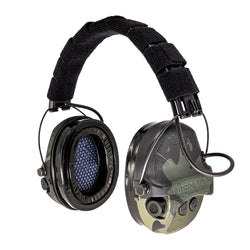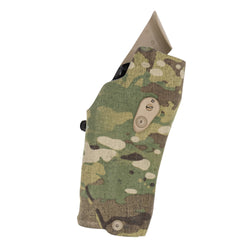Imagining and planning for survival situations is a Rorschach’s test for preppers, gear aficionados, and the everyday person. We project our past experiences and present realities into the gear we select. One person’s kit will not be the same as someone else, as they see things differently.
Along the Gulf Coast, flashlights, power banks, and preserved food are essential for a survival kit geared toward the fallout of hurricanes. Quality sleeping bags and clothing are a priority for the car survival kit in the far North. Those items will keep you alive while you are stranded in a whiteout.
Firearms are less likely to be used than food, flashlights, and matches, but they can be appropriate for a survival kit. Whether it is for taking game, signaling, or defense, firearms can be indispensable. Among the most popular survival firearm options are rimfire rifles, particularly those chambered in .22 LR. Here is why you might want one and why you might consider something else instead:
Rimfire Rifles for Survival: A Prepper’s perspective

When discussing rimfire rifles for survival situations, the conversation inevitably skews towards a prepper’s mindset. That mindset often involves a short- or long-term collapse in utilities, social services, and rule of law.
For the prepper, rimfire rifles, due to their low cost, low recoil, and mild report, make for a great training aid to teach new shooters the fundamentals. A quality rimfire rifle like the Ruger 10/22 can be had for under $300 and a box of 50 rounds of ammunition will set you back $5. On economy alone, the .22 rimfire is twice as cost effective as a middling AR or shotgun platform.

The small size of .22 rimfire ammunition allows you to store or carry more ammunition than the alternatives. A box of 50 rounds of .22 LR weighs only 152 grams and can be stored in a shirt pocket. A 50-round box of conventional 9mm Luger ammunition is bulkier and weighs down your pants at 649 grams.

From a game getting perspective, the small size of the ammunition and its relatively low velocity make it ideal for dispatching small game without doing too much meat damage. That same characteristic also makes the rimfire a natural round to suppress. The already quiet .22 LR can be dropped to Hollywood quiet, particularly with standard velocity and subsonic ammunition. That comes in handy if you don’t want the sound of a gunshot advertising your position to game and two-legged predators.
Rimfire Rifles: Survival Perspectives
All of the advantages of rimfire rifles, as listed above, lend itself well to prepping for potential break downs in supply and the rule of law. These advantages also presuppose a situation of mobile and social survival in an extraordinary situation. But that may not necessarily be the case outside the prepper realm, when the inflection point is something less dramatic—losing power during a hurricane, a vehicle becoming stuck in a snowdrift, or getting lost or medically stranded during a simple day hike. In situations such as these, the strengths of a rimfire rifle come out, but so do the disadvantages that are often overlooked.

Although the economy of buying and employing a .22 rifle in a survival kit is a bonus, the weight and bulk of the rifle and ammunition is the chief selling point. In your hiking pack or in your car breakdown kit, a box of 50 rounds of .22 LR takes up little space and is easy to forget until you need it.
But the rimfire rifles themselves are also lighter than their centerfire counterparts. There are even dedicated takedown rifle platforms that break down such as the Henry AR-7, Savage Model 64, and Ruger 10/22 takedown. These trimmed down rifles weigh anywhere from 3-5 lbs. and can fit into a conventional backpack. Options like these allow you to have an actual rifle that is easy to shoot and just powerful enough for game. The weight and light recoil can also be advantageous if you incur an injury and are unable to wield heavier and more powerful alternatives. But the lightness of rimfire ammunition can be an unexpected disadvantage.
Pitfalls of Rimfire Rifles
The advantage of rimfire rifles in survival situations can also be its great disadvantage. .22 rimfire ammunition has killed anything and everything, but its low power relative to other options can leave the survivalist otherwise set up for success wanting for something more. As glorious as it may seem to build shelters, take game, and strike fires, survival is only about finding a way out of your misery. It can be as mundane as taking stock of the situation, finding a particular piece of kit, and getting out of that scenario.
Instead of taking game, you can use your firearm to signal for assistance. That .22 rifle that is so easy to pack away can save your life, but it can also be frustratingly quiet compared to the alternatives. The low power and light weight of that .22 rimfire ammunition might not be able to cut through the atmosphere to be heard.

Even when employed for game getting and personal defense, the low power of .22 rimfire can be a source of frustration. These slow-moving rounds drop and drag more in the wind compared to centerfire rifle rounds. Beyond 100 yards, conventional .22 LR ammunition high velocity rounds have already dropped a few inches and beyond that distance, the decay is more dramatic.
The rimfire requires you to get close to deliver that small bullet where it needs to go. But even within its limitations, the .22 rimfire is not perfect. It lacks a cone of multiple projectiles that can net you a bird in flight and lacks the power to take big game, save for a well-placed shot that you may not have the luxury of taking. In scenarios where the terrain is too open and with birds and dangerous game on mind, a lightweight break-action shotgun or a centerfire rifle begins to sound better.
Rimfire Rifles for Survival: Assess Before You Pack
After assessing space and weight requirements as well as the most likely scenarios over those that are least likely, I ultimately arrived at a rimfire rifle for the survival pack. The distances employed will likely be short and the game usually small, but most importantly, I am more likely to have it with me than not.
Rimfire rifles excel in their role as survival guns, but they are not the end-all-be-all. Only after assessing your abilities, your space, and your environment can you arrive at an informed decision. But don’t let their smaller size fool you, as a rimfire rifle can be the right tool for the job.









